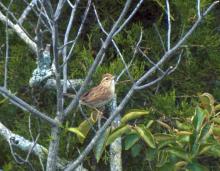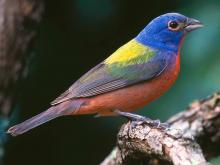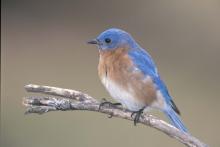Birds
Media

Species Types
Scientific Name
Peucaea aestivalis (formerly Aimophila aestivalis)
Description
Bachman's sparrow is a large, ground-nesting sparrow that lives in dry, scrubby areas. It is listed as endangered in Missouri, where its historic habitat is in decline.
Media

Species Types
Scientific Name
Setophaga castanea (formerly Dendroica castanea)
Description
The male bay-breasted warbler is easy to identify, while females and nonbreeding males present a challenge. This species migrates through Missouri in spring and fall.
Media

Species Types
Scientific Name
Icterus spurius
Description
The orchard oriole is a common summer resident in Missouri. Males are rusty and black; females are olive green and yellowish. Look for them high in trees in places with scattered trees, especially near water.
Media

Species Types
Scientific Name
Passerina ciris
Description
The male painted bunting is one of the most colorful birds in North America, with its blue head, red underparts, and green back. Look for it in tangles and thickets in the southwest part of our state.
Media

Species Types
Scientific Name
Passer domesticus
Description
The house sparrow was brought to America from Europe, but instead of controlling insect pests, it became a pest itself. Also called the English sparrow, its hordes compete with native birds for nesting sites.
Media

Species Types
Scientific Name
Sialia sialis
Description
The eastern bluebird is the state bird of Missouri. Many say its song sounds like “Cheer cheerful charmer.” The male has blue upperparts and rusty and white underparts.
Media

Species Types
Scientific Name
Passerella iliaca
Description
The fox sparrow is our largest sparrow and is named for its foxlike color. It commonly rustles through the leaves and seeds under bird feeders, kicking with both feet at the same time.
Media

Species Types
Scientific Name
Zonotrichia querula
Description
The Harris's sparrow's black bib, face, and crown contrast sharply with its gray cheeks, white belly, and pink beak. In winter, seek this bird in brushy fields and open woods in western Missouri.
Media

Species Types
Scientific Name
Haemorhous mexicanus
Description
A time traveler from the 1970s or before would be amazed to see so many house finches in Missouri, for they are native to the American West. Now it's a common Missouri backyard bird.
Media

Species Types
Scientific Name
Hylocichla mustelina
Description
This is the melodious “bell bird” of Missouri forests. Though this relative of the American robin and eastern bluebird might be hard to locate, its flutelike voice decorates the sound of woodlands the way wildflowers decorate the forest floor.
See Also







Media

Species Types
Scientific Name
Hemaris diffinis
Description
The snowberry clearwing is a moth that confuses people because it looks like a bumblebee and flies like a hummingbird!
Media

Species Types
Scientific Name
Hyles lineata
Description
The white-lined sphinx moth sometimes confuses people because it flies, hovers, and eats from flowers like a hummingbird. The adults often fly during daylight hours as well as in the night and are often found at lights.
Media

Species Types
Scientific Name
Darapsa myron
Description
The Virginia creeper sphinx moth is common in woods and brushy areas and comes to lights at night. The larvae eat Virginia creeper and grape leaves.
Media

Species Types
Scientific Name
Perimyotis subflavus (formerly Pipistrellus subflavus)
Description
Tri-colored bats, formerly called eastern pipistrelles, are relatively small and look pale yellowish or pale reddish brown. The main hairs are dark gray at the base, broadly banded with yellowish brown, and tipped with dark brown.
Media

Species Types
Scientific Name
Myotis grisescens
Description
Gray myotises are difficult to distinguish from other mouse-eared bats. A key identifying feature of the gray myotis is that its wing is attached to the ankle and not at the base of the toes. It’s an endangered species.
Media

Species Types
Scientific Name
Myotis lucifugus
Description
The little brown myotis (little brown bat) is one of our most common bats, but populations are declining. White-nose syndrome has taken a heavy toll in northeastern states. This species is now listed as vulnerable across its range.
Media

Species Types
Scientific Name
Myotis sodalis
Description
The Indiana myotis, or Indiana bat, summers along streams and rivers in north Missouri, raising its young under the bark of certain trees. It is an endangered species.
About Birds in Missouri
About 350 species of birds are likely to be seen in Missouri, though nearly 400 have been recorded within our borders. Most people know a bird when they see one — it has feathers, wings, and a bill. Birds are warm-blooded, and most species can fly. Many migrate hundreds or thousands of miles. Birds lay hard-shelled eggs (often in a nest), and the parents care for the young. Many communicate with songs and calls.





















